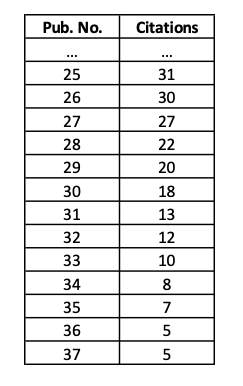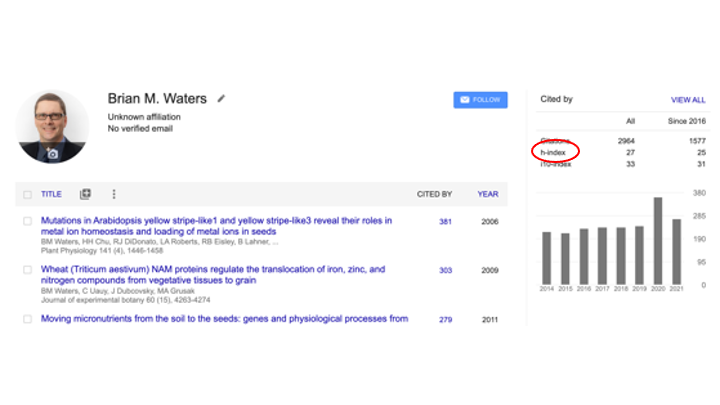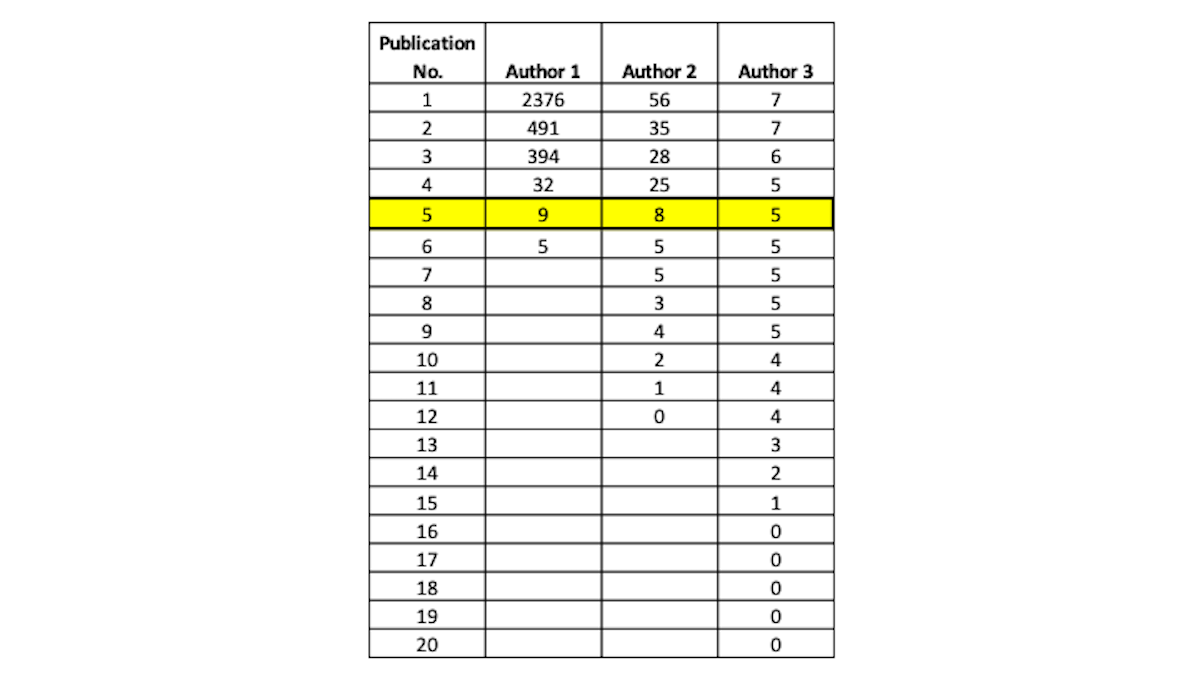Have you heard of the h-index? In a previous post we talked about the Journal Impact Factor, and how it is sometimes misused to evaluate individual researchers based on the journals that they publish their papers in. A better way to measure the impact of individual scientists is the h-index, keeping in mind that the h-index is a single metric, so it should not be considered an all-inclusive number. Still, it is a good way to look at the productivity and impact of an individual researcher.
The h-index is based on: a) the number of journal articles an author has published and b) the number of citations to those journal articles. It is the combination of those two factors that makes up the h-index. Let’s take a look at where the h-index came from. The original paper that describes the h-index is called “An Index to Quantify an Individual’s Scientific Research Output” by J.E Hirsch, published in 2005. Dr. Hirsch “proposes the index h, defined as the number of papers with citation number higher or equal to h, as a useful index to characterize the scientific output of a researcher”. Another quote is: “a scientist has index h if h if his/her Np papers have at least h citations each …”. I find that a little bit confusing, so let’s look at Fig. 1 from the paper.

To make such a figure, sort the author’s publications from most highly cited to least cited, then plot number of publications on the X-axis, and plot the number of citations to each publication on the Y-axis. The solid curve is a hypothetical output, where the intersection of these two axes on curve is the h-index. But there’s a simpler way to do it, and that’s just to look at the two columns of numbers used to make the plot.
As an example we can calculate my h-index after importing my publications and sorting them in Excel. When we get down to row 27, you can see that on my 27th publication I have 27 citations, and so my h-index is 27. And that number can never go down, but it can go up to reach 28 or higher, limited only by the total number of publications. What’s it going to take for my h-index to go to 28? Well my 28th paper has 22 citations, so it needs to be cited an additional six times for my h-index to reach 28. Each individual step moving up the h-index ladder is harder and harder, because you have to get more and more citations on each paper to move up that ladder.
Another way to know your h-index is to set up a Google Scholar profile. Make sure all of your publications are listed and that none of the publications belong to somebody else who has the same name as you. Sometimes that happens to me, and I have to manually remove those publications from my Google Scholar profile. Once you have a Google Scholar profile, it shows your h-index right on the profile.


Now a few things to consider about the h-index. One positive about the h-index is that it looks at the whole body of work and the citations to a number of papers; it doesn’t become distorted by a few highly cited articles. For example, if some authors have one or two publications that are very highly cited, that’s not going to change the h-index (see example below). One of the problems with the journal impact factor is that it is influenced by a small number of highly cited articles that drive up the average citation count. The h-index is a metric of cumulative impact, both productivity and citation rate. Also, as mentioned above, the h-index can go up, but it can never go down, unlike the journal impact factor that fluctuates from year to year. One drawback to the h-index is that established researchers will likely have a higher h-index than newer researchers. For early career researchers that only have three or four publications, there is no way for their h-index to go higher than three or four. They have to build up their publication number to increase their h-index. So, the h-index is not useful for comparing researchers at different stages of their careers. It is also difficult to use the h-index to compare researchers in different fields, because different fields might have different average citation rates. One of the things that’s discussed in the original h-index paper by Dr. Hirsch is that physics has lower citation rates, on average, than biology, and so comparing researchers of equal productivity in those two fields is not going to be fair if you are using the h-index alone. Another consideration for the h-index is that it doesn’t take into account contributions. For example, you might have someone who is the PI of a group, and they’re going to get equal credit on the h-index as somebody who is their long-term research technician who is on a lot of publications.
I mentioned that you should not use the h-index by itself to evaluate an individual researcher, because it doesn’t give you the whole story. You also need to look at the distribution of their publication output and their citation output. Let’s look at an example of three hypothetical researchers that all have the same h-index.
If you look at this distribution carefully you can see that author 1 is having a lot more impact in the field than author three, and also more impact than author 2, in terms of publication citations, even though author 1 has the fewest publications of the three. So, the h-index alone does not really represent what’s happening.
Do you have any additional thoughts or questions about h-index? Leave a comment below!


0 Comments
Trackbacks/Pingbacks